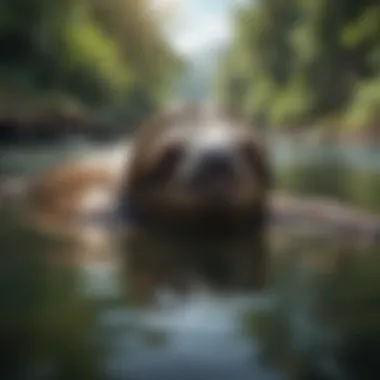The Remarkable Swimming Abilities of Sloths


Nature Topic Overview
Sloths, the often-overlooked stars of the animal kingdom, have an unexpected talent: swimming. Most people picture sloths languidly hanging from trees, but they are quite adept in the water. Their unique adaptations allow them to move gracefully through aquatic environments, serving as a step away from their otherwise slow-paced life. This section will explore the remarkable abilities of sloths in swimming, including how their physical features and behaviors contribute to this skill.
One fascinating aspect of swimming for sloths is their physiological structure. For instance, their long arms play a major role in pulling themselves through water, while their semi-webbed feet assist in propelling them. When they decide to take a dip, they can hold their breath for longer periods than one might think — up to 40 minutes — which is quite impressive for any animal!
Moreover, swimming is not merely a recreational activity for sloths. It serves practical purposes. It allows them to navigate between trees when their preferred routes are obstructed, and they also rely on this skill to escape predators. Quite the survival tactic!
Fun Facts and Trivia
- Did you know sloths can swim three times faster in water than they can move on land? That’s right! Their muscle movements change significantly when submerged.
- While they move slowly on land, sloths have a secret talent: they can paddle through water with intricate strokes, almost like a natural swimmer.
- Sloths have a special adaption in their lungs that helps them stay buoyant while swimming — they can float effortlessly!
Wildlife Explorations
The world of sloths is unique, but they share their habitat with various other creatures. In the lush rainforests of Central and South America, you can find colorful birds, curious monkeys, and even resilient reptiles. Each of these species adapts to the same environment but in different ways, illustrating the rich tapestry of life.
For instance, howler monkeys swing through trees noisily, while capybaras lounge near water sources. Understanding these relationships adds depth to the ways sloths navigate their surroundings.
Species Related to Sloths
- Brown-throated sloth – known for its distinctive markings and primarily tree-dwelling lifestyle.
- Hoffmann's two-toed sloth – notable for its two toes and a calm demeanor.
Environmental Awareness
The importance of maintaining a healthy ecosystem cannot be overstated. Sloths, as part of this intricate web of life, play their role by impacting the foliage they inhabit and the creatures they interact with.
Tips for Kids to Protect Nature
- Participate in community clean-ups to help keep habitats clean.
- Educate others about the importance of rainforests.
- Create a rainforest garden at home using native plants to support local wildlife.
DIY Nature Activities
Engaging with nature can be both fun and educational. Here are some activities kids can do to learn more about sloths and their environments:
Craft: Make a Sloth Puppet
- Gather materials: brown paper bags, googly eyes, and scraps for decorating.
- Follow simple steps to create a sloth puppet; simply folding and gluing will do.
- Use your puppet to act out a sloth’s swimming adventure!
Nature Walk
Take a purposeful stroll in a local park or forest. Observe animals in their habitat, just like sloths do. Bring a notebook to jot down interesting things you see — is there a river nearby where animals might swim?
Engaging with these activities not only enhances understanding but also strengthens the bond with the environment. Sloths remind us that every creature has its unique talents, even in the water.
Foreword to Sloths and Their Habits
What defines a sloth?
A sloth is an animal that belongs to the family Megalonychidae and Bradypodidae, known for its leisurely pace and moving exclusively in trees. These curious mammals have long limbs and a clawed appendage that allow them to hang upside down from branches in a manner that’s quite impressive. Sloths are known for their sluggishness, having a metabolism that slows down in correlation with their low-energy diets. It's a common misinterpretation that this slowness is a disadvantage; rather, it's an adaptation. Their defining characteristics include:
- Speed: Sloths are among the slowest mammals, averaging a speed of about 0.03 miles per hour.
- Diet: Their diet consists mainly of leaves, fruits, and flowers, which provide little energy, making their slow lifestyle necessary.
- Habitat: Mostly found in Central and South America, sloths are arboreal, meaning they spend most of their lives in trees.
Understanding these traits not only sets the stage for their swimming skills but also highlights the sloth's unique place within the ecosystem. Little do many people know, these seemingly lethargic animals have a hidden talent for swimming that plays a crucial role in their survival.


Typical behavior and lifestyle of sloths
The lifestyle of sloths can be quite fascinating once one begins to scratch the surface. They spend the majority of their time resting, sleeping, or slowly moving through the canopy. A sloth is known to sleep for about 15 to 20 hours a day! But there's much more to their behavior:
- Solitary Nature: Sloths are generally solitary animals. They prefer to have their own space, but they are not territorial.
- Swimming Ability: When it comes to swimming, sloths are surprisingly adept. They can hold their breath for up to 40 minutes, allowing them to escape predators and also forage for food.
- Slow Metabolism: Their slow metabolism doesn’t just affect movement; it influences how they absorb nutrients from their leafy diet, which in turn impacts their energy levels.
This distinctive lifestyle illustrates just how uniquely equipped sloths are for their environment. Their behaviors are a direct reflection of their ecological niche, where each element—from movement to diet—plays a crucial role in their overall survival in a world that's constantly changing.
“Understanding sloth behavior provides invaluable insight into their surprising skills, particularly their swimming capabilities, which are essential for their survival.”
This introduction serves as a gateway into the detailed exploration that follows, revealing how various aspects of sloth anatomy and behavior seamlessly intertwine to create a picture of this remarkable animal.
Anatomy of Sloths: The Key to Swimming
Understanding the anatomy of sloths is crucial to grasp how these seemingly slow creatures can navigate through water. Sloths, with their unique physical traits, have adaptations that allow them to swim efficiently, despite what one might assume about their leisurely nature. By examining their muscle structure, limb adaptations, and skin characteristics, we can appreciate how these features contribute to their swimming skills.
Muscle structure and composition
Sloths boast a distinctive muscle composition that plays a significant role in their swimming abilities. While you might think of sloths as being all about moving slowly, their muscles are tailored more for endurance. The muscles are less about raw power and more about sustaining long periods of activity. This is essential when they glide through water, as they may need to swim for distances to find their way.
In particular, the muscles surrounding their limbs are structured to support both climbing trees and paddling through water. This dual-purpose muscle function enables sloths to transition seamlessly between their terrestrial and aquatic environments, demonstrating an impressive feat of adaptation.
Additionally, their muscle fibers contain a high proportion of slow-twitch fibers, which are great for stamina but not for quick bursts of speed. In water, however, this allows sloths to maintain a steady pace over longer distances when necessary.
Limb adaptations for swimming
The limbs of sloths are specially designed to support their swimming technique. Instead of straight, rigid arms, sloths have long, flexible limbs, equipped with sharp claws that serve multiple purposes. Their arms are quite elongated, allowing for a wider reaches when they paddle through water. These claws may dig into surfaces as they propel themselves forward, acting almost like paddles.
When in the water, sloths adopt a unique style of propulsion—using a combination of their forelimbs and hind limbs. A technique not unlike dog paddling is observed, where their limbs alternate in a smooth motion. This adaptation ensures they maneuver gracefully through the water, proving that evolution has its way of refining strategies for survival.
One often-overlooked aspect is how the sloth's joints function under pressure. Unlike other animals that may have evolved to swim, sloths have greater flexibility in their limb joints, allowing them to change their swimming technique depending on the water conditions.
Unique adaptations in fur and skin
The fur and skin of sloths are not just for show; they're pivotal to their aquatic life too. Sloths possess a unique fur texture that is not only thick but has a certain degree of buoyancy. This characteristic allows them to float for brief periods while conserving energy during longer swims.
Moreover, the fur is home to various species of algae, which not only camouflages sloths among the leafy greens of their treetop habitat but also helps in buoyancy. When they swim, the water interacts differently with their fur, allowing them to maintain an equilibrium in the water. The algae’s green color is a clever evolutional strategy—blending perfectly with the surroundings they often hang out in.
On the surface of their skin, a unique oily secretion aids in water resistance, keeping them insulated and dry to a degree, even when they find themselves fully submerged. This adaptation proves essential as it protects sloths from chilly waters and helps them withstand different weather conditions.
Therefore, it is clear that sloths have undergone remarkable evolutions to thrive in both tree canopies and shallow waters. Their anatomy tells a story of survival that parallels their ecological habitats.
Altogether, it’s fascinating to see how the anatomy of sloths is intricately connected to their swimming prowess. All these factors combine to showcase how this curious creature is much more than a sluggish animal; it is a well-adapted swimmer who navigates its environment with surprising skill.
The Swimming Technique of Sloths
The swimming technique of sloths is nothing short of fascinating. These creatures, typically associated with slow, lethargic movements, actually showcase incredible adaptations when they enter water. Understanding these methods can provide insights not only into their lives but also into their survival strategies.
How sloths propel themselves through water
Swimming is one area where sloths demonstrate surprising agility. Despite their bulk and famously slow-moving tendencies, sloths utilize their long limbs to navigate through water. When they swim, they stretch out their arms and legs, moving them in a coordinated manner that is somewhat similar to the breaststroke that humans employ. This enables them to choose the right angle for pushing off against the water, allowing for greater propulsion. Their fur, which is dense and slightly hydrophobic, helps reduce drag, enabling them to glide with surprising ease.
Notably, sloths can hold their breath underwater for a significant amount of time, generally around 40 minutes. This ability serves them well, as it allows them to swim across rivers in their rainforest habitats, sometimes moving from one tree to another. Sloths have been observed gracefully sliding through the water, making them adept swimmers despite their reputation for being slow on land.
Breathing techniques while swimming
Breathing techniques are crucial for sloth survival when submerged. When sloths swim, they instinctively hold their breath, using their body’s capacity to remain under water for longer than most other mammals. Their body adapts to regulate oxygen efficiently, allowing them to float and maneuver without frequently surfacing.
Interestingly, sloths possess specialized lungs that enable them to absorb oxygen effectively while swimming. Their need to breathe is correlated to their activity levels; when they are swimming, their heart rate slows, conserving oxygen and energy. This unique combination of adaptations allows them to master their environments and evade potential threats.
Comparison with terrestrial locomotion
When it comes to terrestrial locomotion, sloths can appear clumsy. They often move deliberately and at a leisurely pace, which can make them an easy target for predators. However, this same methodical approach proves beneficial when they are in water. Although they exhibit slow movement on land, their swimming technique emphasizes a fluid motion that is both efficient and strategic.
In contrast, on land, sloths tend to move in a jerky fashion, climbing trees or hanging upside down to graze on leaves. The shift from slow land movement to efficient and graceful swimming is a striking transformation. Instead of mimicking a frantic panic like many creatures when in water, sloths reveal a calm confidence in their swimming capabilities.


Understanding these differences is vital for appreciating their abilities and recognizing their place in the ecosystem. It turns out, what seems like a leisurely lifestyle on the ground can translate into exceptional skills when navigating their aquatic surroundings.
"The versatility of sloths in both terrestrial and aquatic environments highlights their adaptive nature and resilience."
In summary, the swimming technique of sloths showcases a remarkable juxtaposition to their everyday movements on land. Their ability to propel themselves effectively through water, coupled with well-adapted breathing techniques and distinct locomotion patterns, paints a vivid picture of these unique animals as more than just slow-moving creatures in the forest.
Ecological Significance of Sloth Swimming
Swimming isn’t just a curious ability for sloths; it plays a major role in their survival and daily routines. Understanding the ecological significance of sloth swimming can shed light on their interactions within their environment.
Role of swimming in foraging behavior
Sloths have a peculiar relationship with their food source, primarily relying on leaves from trees that are often high up. However, when these leafy meals are scarce, or to access different species of trees that may be farther away, they sometimes have to take a dip. Swimming allows sloths to reach new territory where they can find fresh leaves to munch on, crucial for their energy needs.
- Nutritional diversity: By swimming, sloths can diversify their diet. Instead of munching down on the same few leaves all the time, they can explore various trees in nearby areas.
- Access to different ecosystems: Many trees are found across rivers and streams. In this way, swimming helps them forage in different ecosystems, utilizing a broader range of resources to satisfy their hunger.
- Seasonal benefits: During dry seasons when foliage is less plentiful, the ability to swim enables sloths to seek nourishment more effectively.
"When swimming, sloths may also consume aquatic plants or fruits that fall into rivers, enhancing their diet even more."
Importance for avoiding predators
In the wild, sloths face a number of threats. Jaguars and other carnivores are known to prey on them. By taking to the water, sloths often find a way to evade these predators.
- Escape routes: Sloths are generally slow, but when they enter the water, they can move surprisingly well. This can help them escape a lurking predator that may be stalking them on land.
- Natural camouflage: Their bodies are well adapted for blending in with the aquatic environment; some sloths can even appear just like a floating clump of vegetation. This makes it difficult for predators to spot them when they are swimming.
- Diversifying their habitat: By using water bodies as a refuge, sloths expand their habitats. This adaptability enhances their chances of survival.
Thus, swimming is not merely a whimsical trait; it plays a crucial part in the ecological strategies of sloths. From finding food to evading danger, their swimming skills are integral to their way of life in the wild.
Sloths in Their Natural Habitats
Sloths are often thought to be lazy creatures, lingering high in the treetops of tropical rainforests. However, the environments where they thrive are far more dynamic and complex than one might imagine. Understanding the typical habitats and ecosystems of sloths is a vital part of appreciating their swimming skills and overall lifestyle. These unique creatures don't just hang around; they actively adapt to their surroundings, forging a connection that is essential for their survival.
Typical environments and ecosystems
Sloths primarily inhabit the lush, tropical rainforests of Central and South America. These areas are rich in biodiversity, filled with towering trees and thick foliage.
- Canopy Life: The canopy, where sloths spend much of their time, provides not just shelter but also access to food sources like leaves, fruits, and flowers. The leaves sloths consume have low nutritional value, which is part of the reason they move so slowly. This slow lifestyle allows them to conserve energy while digesting their tough diet.
- Wet Environments: While sloths are tree dwellers, they are also drawn to swamps and marshes, especially in the Amazon. These wetter areas provide additional food choices and access to water for swimming. Despite their sluggish reputation, sloths are actually quite adept at aquatic movements, making the most of their swampy habitats.
Through the interplay of forest and water, sloths navigate their environments with surprising skill. Their adaptations go beyond simply living in trees; they also utilize nearby water sources to enhance their ability to find food and evade predators.
Interplay between aquatic and terrestrial settings
The relationship between land and water in the lives of sloths shows just how versatile these creatures can be. When you think about it, sloths aren’t confined to one particular setting.
- Swimming as a Survival Skill: The ability to swim is crucial for sloths. In some cases, they may have to cross rivers or streams to reach food. Their swimming technique varies from their typical slow-motion tree movements. Instead of crawling, they stretch their limbs to paddle through the water, moving with a surprising grace that can’t be overlooked.
- Ecosystem Dynamics: The ecosystems that support sloths are interconnected. The health of water sources affects the forest, and vice versa. Slow-moving water bodies, for instance, are breeding grounds for fish and insects, which in turn attract other wildlife. This biodiversity benefits sloths by ensuring a wide range of prey and plant life that they depend on.
Understanding how sloths interact with both aquatic and terrestrial environments underscores the importance of preserving their habitats. As these animals tread the line between forest and water, they symbolize the delicate balance that exists in nature.
Sloths' ability to thrive in diverse environments not only highlights their adaptability but also opens a discussion about the conservation efforts necessary to protect these habitats. Their swimming skills, evolving from life within their natural settings, remind us that there's a lot more than meets the eye in the world of these fascinating animals.
Challenges and Threats to Sloths
The life of sloths, often seen hanging lazily from tree branches, is far from easy. There are specific challenges and threats that these fascinating creatures face, both in their natural habitats and as a consequence of human activity. Understanding these challenges is crucial. Not only does it shed light on the daily struggles sloths endure, but it also emphasizes the significance of conservation efforts aimed at preserving their populations.
Impact of habitat loss on sloth populations


Habitat loss is perhaps one of the most pressing issues for sloths today. As rainforests are increasingly cleared for agriculture, logging, and urban development, sloths lose their homes. This deforestation reduces the trees they depend on for food and shelter.
When sloths wander away from their habitat in search of food, they often find themselves in dangerous situations, like crossing roads where they can be hit by vehicles or encountering predators they wouldn't normally face. As a result, many sloth populations decline, struggling to survive in fragmented environments.
"Every tree cut down represents a life disrupted for sloths and many other animals," says a wildlife conservationist.
Climate change and its effects on swimming
Climate change also poses a significant threat to sloths. As temperatures rise and weather patterns shift, sloths experience an impact on their aquatic skills and food resources. These special creatures rely on water for cooling, but altered rainfall patterns can lead to droughts, reducing their access to water sources.
Additionally, as river and stream levels change, the natural retention of aquatic ecosystems may shift too. This can affect the food sloths find in the water and can even alter the rivers' speed and current.
Increased temperatures can also lead to health issues among sloths, making them less able to swim effectively. If their swimming skills decline, so too does their ability to escape predators or find food—ultimately threatening their survival.
Conservation Efforts for Sloths
Conservation efforts for sloths are crucial in ensuring the survival of these unique creatures. As the world opens its eyes to the extraordinary capabilities of sloths, especially their swimming skills, it becomes increasingly clear that safeguarding their habitats is vital. Sloths may be known for their slow movements, but they play an important role in their ecosystems. By addressing the threats they face, we can foster healthier habitats that allow sloths to thrive.
Current conservation initiatives
Numerous organizations and groups have launched various conservation initiatives aimed at protecting sloth populations and, by extension, their habitats. Here are some key efforts currently in place:
- Habitat Preservation: Many organizations focus on preserving the tropical rainforests where sloths reside. Efforts include reforestation initiatives and creating protected areas to ensure forests are safe from logging and agriculture.
- Rescue and Rehabilitation Centers: These centers provide shelter and medical care to injured or orphaned sloths. They educate the public on how to care for sloths and the importance of conservation.
- Research Programs: Researchers are looking into sloth behavior, health, and population dynamics to develop more effective conservation strategies.
- Community Engagement: Encouraging local communities to engage in conservation activities has become a central focus. By involving residents in conservation efforts, it promotes a sense of ownership and responsibility toward wildlife protection.
"Conservation is not just about saving animals, but about maintaining the balance of nature that supports us all."
These initiatives reflect a growing awareness of the importance of protecting sloths and their environments, which is crucial for their survival.
How swimming behavior influences conservation strategies
Interestingly, understanding sloth swimming skills can directly inform conservation strategies. Here's how:
- Awareness of Habitat Needs: Recognizing that sloths swim effectively emphasizes the need for preserving water bodies within their natural habitats. These areas must be kept clean and available for sloths to access.
- Restoration Programs: Since sloths swim to escape predators or find food, conservation strategies now include restoring riverbanks and wetlands where sloths forage.
- Raising Public Interest: Highlighting sloths’ unique swimming abilities can spark interest and excitement about their conservation. When people learn how sloths interact with their ecosystem, they may become more inclined to support conservation efforts.
- Policy Changes: Policymakers can create regulations to protect both terrestrial and aquatic environments by integrating research about sloth swimming behaviors into legislation.
These approaches illustrate that sloth conservation is not just about the animals themselves, but also about the intricate environments they depend on.
Ending and Future Directions
Recap of sloth swimming skills and behavior
Sloths are known for their leisurely pace on land, but they are surprisingly adept swimmers. Unlike many terrestrial mammals, they utilize a unique propulsion method, moving their limbs in a coordinated fashion while turning their heads for breathing. This not only allows them to traverse rivers but also highlights their adaptability—something that might come off as unexpected.
Here are some key points about sloth swimming skills:
- Propulsion: Sloths use their long arms to paddle through the water effectively.
- Breathing: They have the ability to hold their breath for over 40 minutes while swimming, which is quite remarkable.
- Ecological adaptation: Swimming helps sloths in foraging, enabling them to reach various food sources that may be unavailable on land.
Their behavior showcases a fascinating dual lifestyle, balancing both aquatic and terrestrial habitats, which is essential for their existence in the wild.
Future research opportunities
When it comes to future research on sloth swimming skills, there are many avenues to explore. Understanding how climate change affects their swimming behavior and habitats presents a paramount opportunity. As water levels shift and ecosystems change, studying these impacts could lead to vital conservation strategies.
Additionally, scientists could investigate the neurological aspects of swimming in sloths. How does their brain coordinate such different locomotion methods? This inquiry could reveal insights into their cognitive functions.
Moreover, research into the genetic adaptations that allow sloths to thrive both in trees and in water could uncover valuable information about their evolution. Examining these elements can help conservationists create targeted efforts to protect sloth populations, ensuring their survival as they face increasing threats.
"Understanding the swimming habits of sloths provides a lens through which we can grasp their ecological roles and ensures we take wisdom from nature to guide our conservation strategies."
By diving deeper into these aspects, we can build a more complete picture of sloths, ensuring that we appreciate not just their quirks but contribute positively to their future.







